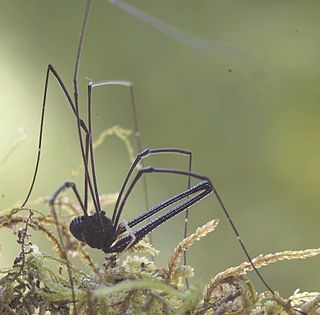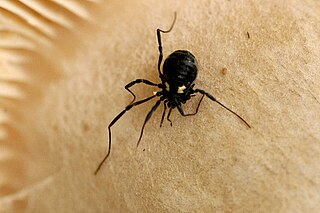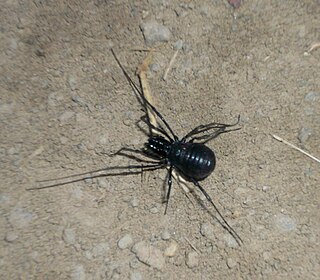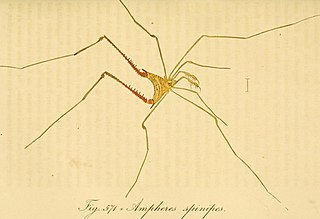
The Opiliones are an order of arachnids colloquially known as harvestmen, harvesters, harvest spiders, or daddy longlegs. As of April 2017, over 6,650 species of harvestmen have been discovered worldwide, although the total number of extant species may exceed 10,000. The order Opiliones includes five suborders: Cyphophthalmi, Eupnoi, Dyspnoi, Laniatores, and Tetrophthalmi, which were named in 2014.
Cândido Firmino de Mello-Leitão was a Brazilian zoologist who is considered the founder of Arachnology in South America, publishing 198 papers on the taxonomy of Arachnida. He was also involved with education, writing high-school textbooks, and contributed to biogeography, with essays on the distribution of Arachnida in the South American continent.

Opilio is a genus of harvestmen with 35 known species.

Lacronia is a genus of South American harvestmen, which includes four Brazilian species. A striking diagnostic character is the trochanter IV of male with strong medial prolateral apophysis forming a pincer with the dorso-apical apophysis of coxa IV.

Pachylinae is the most diverse subfamily of the harvestman family Gonyleptidae, including around 400 valid species. Major groups of species occur in the Brazilian Atlantic forest, Bolivian/Peruvian highlands, Argentina and Chilean temperate forest.

Cosmetidae is a family of harvestmen in the suborder Laniatores. With over 700 species, it is one of the largest families in Opiliones. They are endemic of the New World with a Nearctic-Neotropical distribution where a large fraction of the diversity of Opiliones are represented by this single family. Cosmetidae have the northern extent of their range into the USA, where a small number species occur in the southern states. However, the family is especially diverse in Mexico, Central America and northern South America; especially the Andean realms. Their range also extends further south into Argentina and southern Brazil, but they are absent in Chile. Cosmetidae are prevalent in Amazonian region, but only relatively few also occur in Brazilian Atlantic Forest. Several species are also found in the Caribbean.

The Sclerosomatidae are a family of harvestmen with about 1,300 known species. One former subfamily has been recently removed to form a new family, Globipedidae.

The Neopilionidae are a family of harvestmen.

The Nemastomatidae are a family of harvestmen with about 170 described species in 16 recent genera. Several fossil species and genera are known.

Assamiidae are a family of harvestmen with more than 400 described species. It is the third most diverse family of the suborder Laniatores.
The Stygnidae are a family of neotropical harvestmen within the suborder Laniatores.
Agoristenidae are a neotropical harvestman family of the Suborder Laniatores, in the superfamily Gonyleptoidea.
The Manaosbiidae are a family of neotropical harvestmen within the suborder Laniatores.

The Cranaidae are a family of neotropical harvestmen within the suborder Laniatores.
Kimulidae is a small neotropical family of the harvestman infraorder Grassatores with about thirty described species.

Ischyropsalis is a genus of harvestmen in the monotypic family Ischyropsalididae, with 24 described species. They are found in Europe.

Ampheres is a genus of neotropical harvestmen
Holcobunus is a genus of the order Opiliones in the family Sclerosomatidae. The genus was first described by Roewer, 1910
Asarcus is a genus of harvestmen in the family Gonyleptidae with four described species. All species are found in Brazil.









